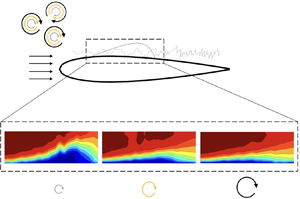Article contents
Disturbance growth in a laminar separation bubble subjected to free-stream turbulence
Published online by Cambridge University Press: 09 February 2023
Abstract

Experiments were conducted to study the transition and flow development in a laminar separation bubble (LSB) formed on an aerofoil. The effects of a wide range of free-stream turbulence intensity ( $0.15\,\%< Tu<6.26\,\%$) and streamwise integral length scale (
$0.15\,\%< Tu<6.26\,\%$) and streamwise integral length scale ( $4.6\ {\rm mm}<\varLambda _{u}<17.2\ {\rm mm}$) are considered. The co-existence of modal instability due to the LSB and non-modal instability caused by streaks generated by free-stream turbulence is observed. The flow field is measured using hot-wire anemometry, which showed that the presence of streaks in the boundary layer modifies the mean-flow topology of the bubble. These changes in the mean flow field result in the modification of the convective disturbance growth, where an increase in turbulence intensity is found to dampen the growth of the modal instability. For a relatively fixed level of
$4.6\ {\rm mm}<\varLambda _{u}<17.2\ {\rm mm}$) are considered. The co-existence of modal instability due to the LSB and non-modal instability caused by streaks generated by free-stream turbulence is observed. The flow field is measured using hot-wire anemometry, which showed that the presence of streaks in the boundary layer modifies the mean-flow topology of the bubble. These changes in the mean flow field result in the modification of the convective disturbance growth, where an increase in turbulence intensity is found to dampen the growth of the modal instability. For a relatively fixed level of  $Tu$, the variation of
$Tu$, the variation of  $\varLambda _{u}$ has modest effects. However, a slight advancement of the nonlinear growth of disturbances and eventual breakdown with the decrease in
$\varLambda _{u}$ has modest effects. However, a slight advancement of the nonlinear growth of disturbances and eventual breakdown with the decrease in  $\varLambda _{u}$ is observed. The data show that the streamwise growth of the disturbance energy is exponential for the lowest levels of free-stream turbulence and gradually becomes algebraic as the level of free-stream turbulence increases. Once a critical turbulence intensity is reached, there is enough energy in the boundary layer to suppress the laminar separation bubble, resulting in the non-modal instability taking over the transition process. Linear stability analysis is conducted in the fore position of the LSB. It accurately models incipient disturbance growth, unstable frequencies and eigenfunctions for configurations subjected to turbulence intensity levels up to 3 %, showing that the mean-flow modification due to the non-modal instability dampens the modal instability.
$\varLambda _{u}$ is observed. The data show that the streamwise growth of the disturbance energy is exponential for the lowest levels of free-stream turbulence and gradually becomes algebraic as the level of free-stream turbulence increases. Once a critical turbulence intensity is reached, there is enough energy in the boundary layer to suppress the laminar separation bubble, resulting in the non-modal instability taking over the transition process. Linear stability analysis is conducted in the fore position of the LSB. It accurately models incipient disturbance growth, unstable frequencies and eigenfunctions for configurations subjected to turbulence intensity levels up to 3 %, showing that the mean-flow modification due to the non-modal instability dampens the modal instability.
- Type
- JFM Papers
- Information
- Copyright
- © The Author(s), 2023. Published by Cambridge University Press
References
- 7
- Cited by





